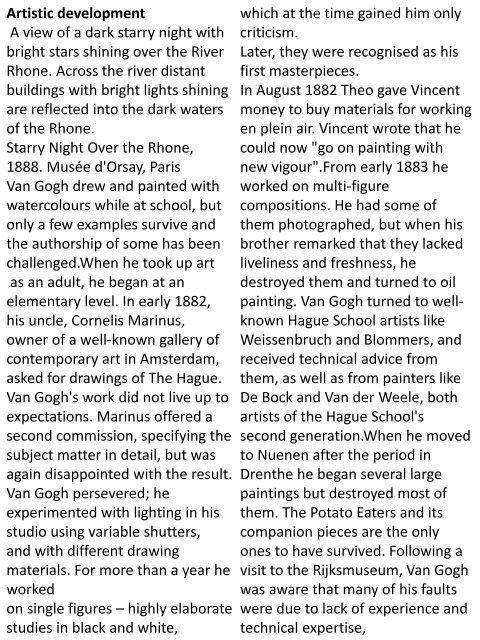Aziz Art September 2016
History of art(west and Iranian)-contemporary art
History of art(west and Iranian)-contemporary art
You also want an ePaper? Increase the reach of your titles
YUMPU automatically turns print PDFs into web optimized ePapers that Google loves.
<strong>Art</strong>istic development<br />
A view of a dark starry night with<br />
bright stars shining over the River<br />
Rhone. Across the river distant<br />
buildings with bright lights shining<br />
are reflected into the dark waters<br />
of the Rhone.<br />
Starry Night Over the Rhone,<br />
1888. Musée d'Orsay, Paris<br />
Van Gogh drew and painted with<br />
watercolours while at school, but<br />
only a few examples survive and<br />
the authorship of some has been<br />
challenged.When he took up art<br />
as an adult, he began at an<br />
elementary level. In early 1882,<br />
his uncle, Cornelis Marinus,<br />
owner of a well-known gallery of<br />
contemporary art in Amsterdam,<br />
asked for drawings of The Hague.<br />
Van Gogh's work did not live up to<br />
expectations. Marinus offered a<br />
second commission, specifying the<br />
subject matter in detail, but was<br />
again disappointed with the result.<br />
Van Gogh persevered; he<br />
experimented with lighting in his<br />
studio using variable shutters,<br />
and with different drawing<br />
materials. For more than a year he<br />
worked<br />
on single figures – highly elaborate<br />
studies in black and white,<br />
which at the time gained him only<br />
criticism.<br />
Later, they were recognised as his<br />
first masterpieces.<br />
In August 1882 Theo gave Vincent<br />
money to buy materials for working<br />
en plein air. Vincent wrote that he<br />
could now "go on painting with<br />
new vigour".From early 1883 he<br />
worked on multi-figure<br />
compositions. He had some of<br />
them photographed, but when his<br />
brother remarked that they lacked<br />
liveliness and freshness, he<br />
destroyed them and turned to oil<br />
painting. Van Gogh turned to wellknown<br />
Hague School artists like<br />
Weissenbruch and Blommers, and<br />
received technical advice from<br />
them, as well as from painters like<br />
De Bock and Van der Weele, both<br />
artists of the Hague School's<br />
second generation.When he moved<br />
to Nuenen after the period in<br />
Drenthe he began several large<br />
paintings but destroyed most of<br />
them. The Potato Eaters and its<br />
companion pieces are the only<br />
ones to have survived. Following a<br />
visit to the Rijksmuseum, Van Gogh<br />
was aware that many of his faults<br />
were due to lack of experience and<br />
technical expertise,


















